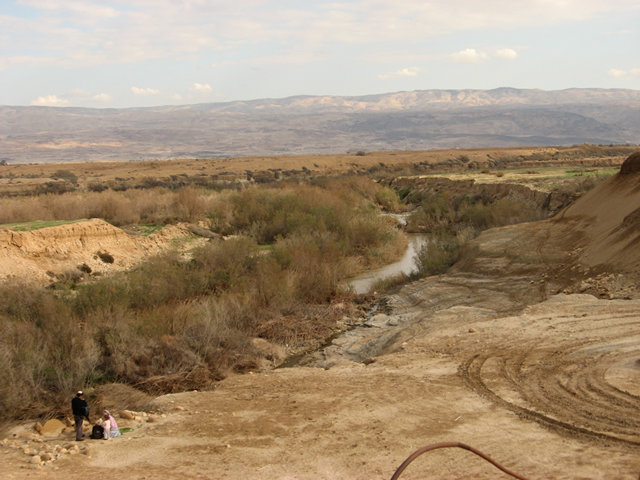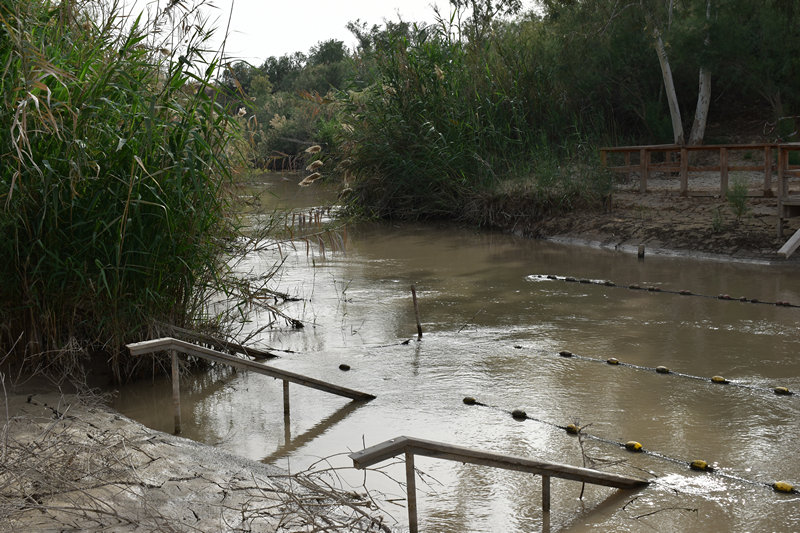History and Tradition
By:

One of the great events in Joshua’s conquest of the Land was the miracle at the crossing of the Jordan River, when the river dried up ten kilometres north of Jericho, and the People of Israel crossed on dry land (Joshua 3:16). From there, the People of Israel went on to conquer Jericho, after setting-up camp in the Gilgal, which is in the Plains of Jericho, sandwiched between the river and the yet unconquered city of Jericho.
Our Rabbis established that one who sees the place where the Jordan River was crossed, should recite the blessing "Who has performed miracles for our Fathers in this place"
.
Twelve stones were taken from the east bank of the river at the crossing point adjacent to the water (Joshua 4:2). These stones are "there to this day"
(Joshua 4:9), most probably buried in the muddy riverbed, to remind us of the miracle.
The crossing of the Jordan took place on the 10th of the month of Nissan, one month and three days after Moses spoke his last to the People of Israel in the Plains of Moab, on the east side of the Jordan opposite Jericho, and from there ascended Mt Nebo (above the Plains of Moab) and departed from this world (Deuteronomy 31:1-13 and 33:1 - 34:12). The date of Moses's death was on the 7th of the month of Adar (Babylonian Talmud: Tractates Megilah p13b, and Kiddushin p38a).
Because of the great number of people crossing with Joshua (600,000 men between the ages of 20 and 50, as well as the women, the young and the old - giving an estimate of 2 to 3 million), the crossing took place over a broad front, probably between the present-day Allenby Bridge and the north tip of the Dead Sea, which extended much further north than today. However, one place symbolises the Jordan Crossing, most probably the very spot where the Cohen priests crossed and where the 12 stones are buried in the riverbed. Today this place is known to the Arabs as "Kasser al Yahud" (the crossing-over of the Jews). Christianity has also made the place into a religious site of its own.
To our disgrace, at this place (or at any other place on the bank of the Jordan), there is no signposting referring to the crossing of the Jordan and the ensuing events. Hopefully, this will be remedied soon.
As a concluding remark, the Jordan Valley between the Sea of Galilee and the Dead Sea, which includes the Biblical Gilgal and the site of the Jordan Crossing at its heart, is not “the land of the monasteries”, as is often advertised in tourist publications, but a foundational part of Jewish history and tradition.
The sequence of events between the death of Moses and the crossing of the Jordan is as follows:
- 7th Adar: Moses dies and is buried by G-d. a 30-day mourning period is observed by the People of Israel (Deuteronomy 34:5-12; Babylonian Talmud: Tractates Megilah p13b, and Kiddushin p38a).
- 6th Nissan: Joshua sends two spies on a reconnaissance mission to Jericho (Joshua 2:1).
- 7th Nissan: The 30-day mourning period for Moses ends. (Tosafot's elucidation on Rashi's commentary on Joshua 1:1; Babylonian Talmud: Tractate Kiddushin p38a).
- 8th Nissan: G-d speaks to Joshua to organise the People to cross the Jordan 3 days hence (Joshua 1:11).
- 9th Nissan: Joshua tells the People to prepare for departing on the morrow (Joshua 3:5).
- 10th Nissan: The Jordan river stops flowing and the People of Israel cross over on the river bed from the Plains of Moab on the east bank of the Jordan to the Plains of Jericho on the west bank of the Jordan (Joshua 3:16-17).
The sequence of events between the crossing of the Jordan and the conquest of Jericho is as follows:
- 10th Nissan: After having crossed the Jordan, the People of Israel set-up camp in the Gilgal, which is in the heart of the Plains of Jericho, between the river and the city of Jericho (Joshua 4:19).
- 11th Nissan: All men born during the 40-year wandering in the desert (who had not been circumcised) are now circumcised with sharp flintstones at the "Givat HaÁralot" [Givat HaÁralot = the mound of foreskins situated within the Gilgal encampment]" (Joshua 5:2).
- 14th Nissan: After recovering from the circumcision during three days, Israel is ready to offer the Passover Sacrifice, the first Passover sacrifice offered in the Land of Israel (Joshua 5:10).
- 15th to 21st Nissan: Israel celebrates the seven days of Passover following the offering of the Passover sacrifice, in their Gilgal encampment.
- 21st to 27th Nissan: Joshua circles the city of Jericho, once every day with the Ark, his warriors and the Priests (Cohanim), blowing their Shofars (Joshua 6:3-14).
- 28th Nissan: Joshua circles the city of Jericho 7 times, together with the Ark, his warriors and the Priests (Cohanim), blowing their Shofars. On the 7th encirclement, the walls of the city sink into the ground, and the conquest starts (Joshua 6:15-20).





